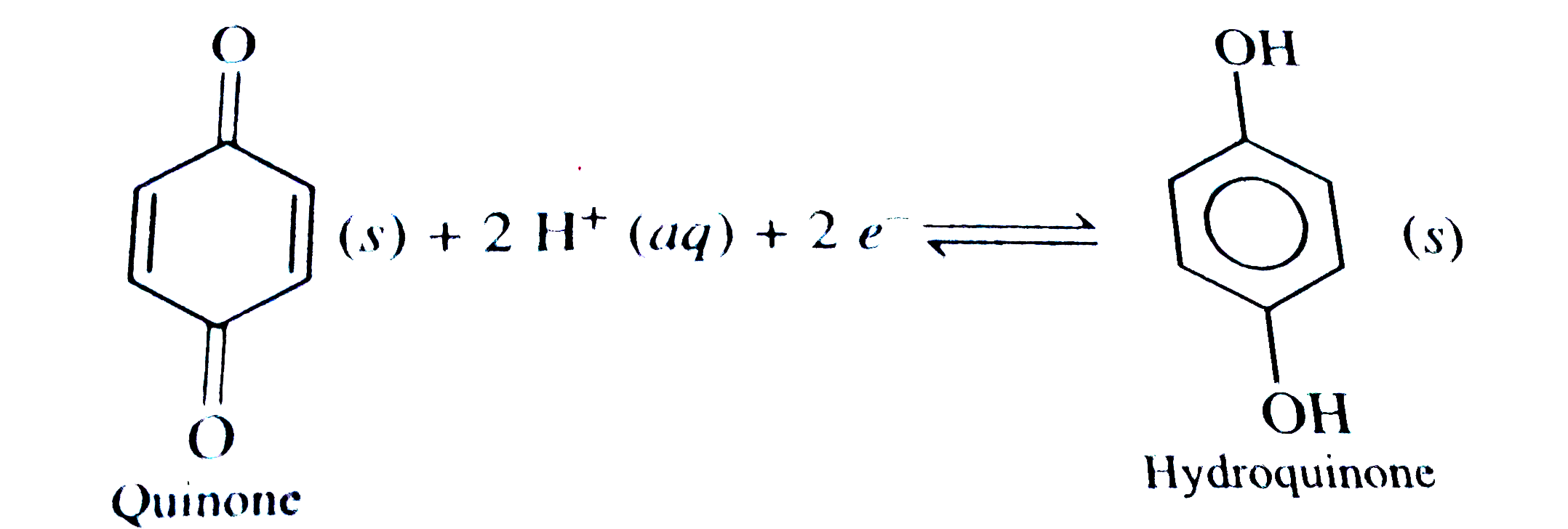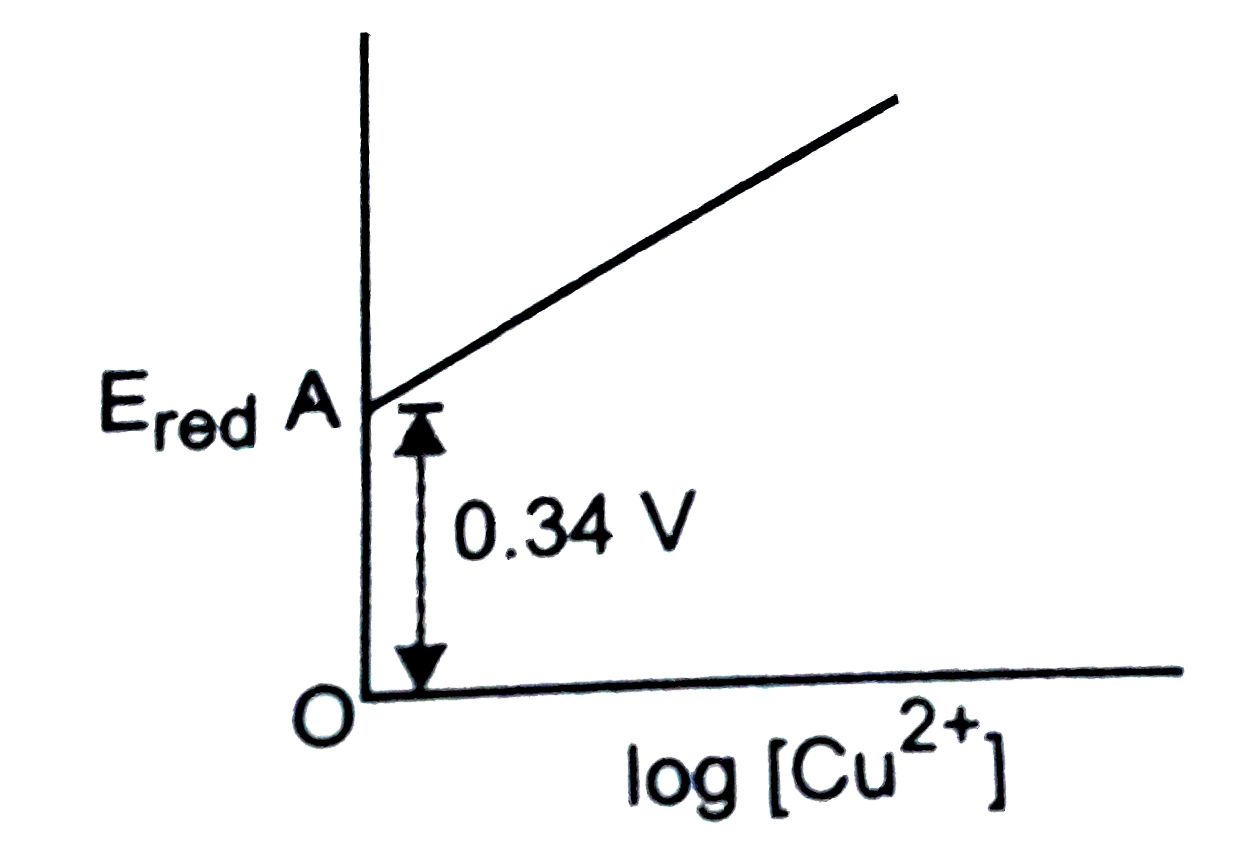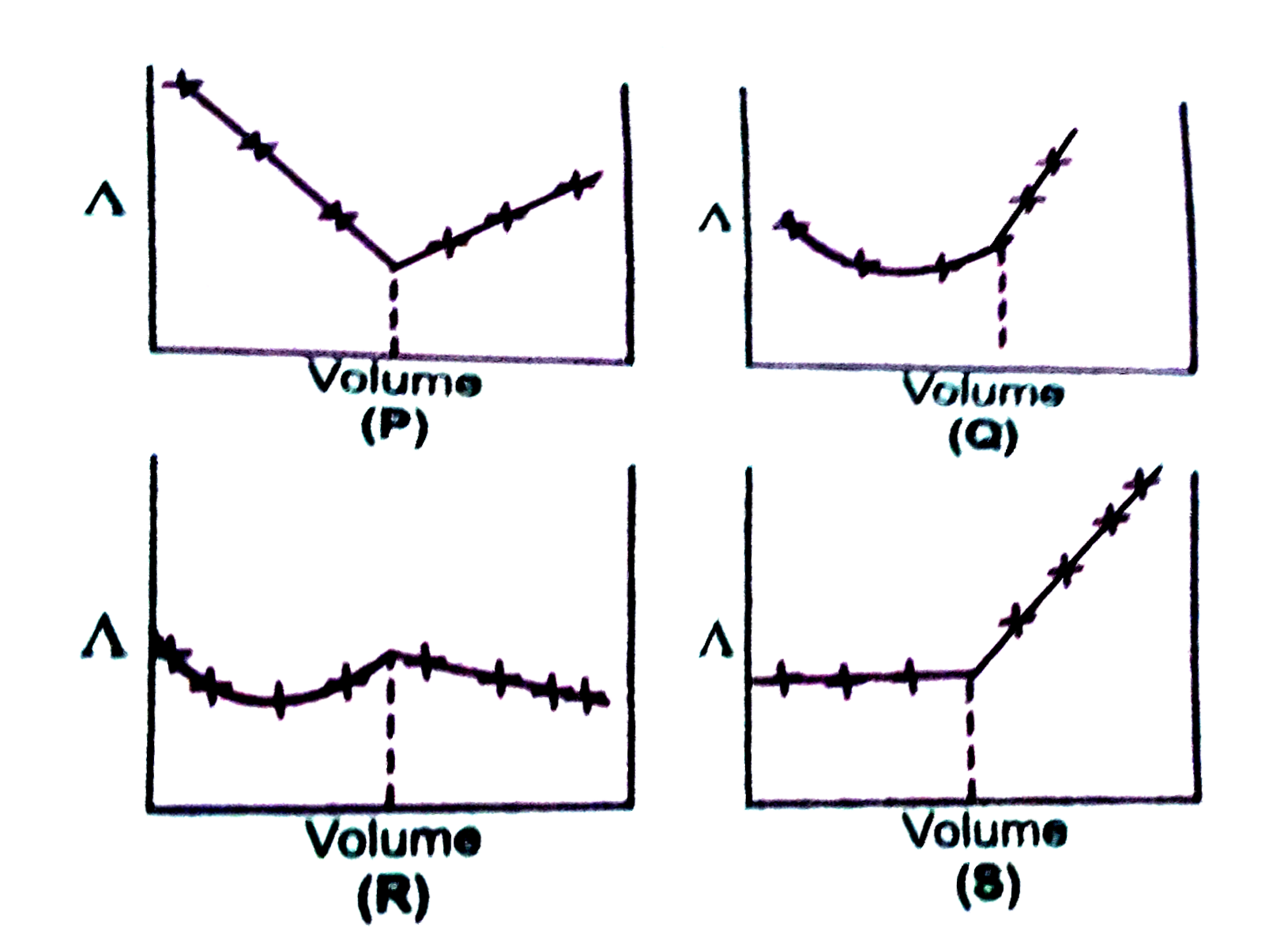Complete Solutions to VALUE BASED QUESTIONS WITH ANWER (Multiple Choice Questions-I) of chapter ELECTROCHEMISTRY of Class 12 book with complete answers and questions
| Class 12 | CHEMISTRY |
| Chapter | ELECTROCHEMISTRY |
| PRADEEP | VALUE BASED QUESTIONS WITH ANWER (Multiple Choice Questions-I) |
| Number Of Questions | 90 |
| Academic Year | 2023-24 |
Rechargable batteries include which of the those below?
(P) Dry cell
(Q) Lead-acid storage battery
(R ) Nickel -cadmium battery
View SolutionSelect the correct direct form of the given sentence.
She asked her mother why she was so upset that day.
View SolutionWhat current is to be passed for 0.25 s for deposition of a certain weight of metal, which is equal to its electrochemical equivalent?
View SolutionIn an exper iment 0.04F was passed through 400mL of 1 M solution of NaCl. What would be the pH of the solution after electrolysis?
View SolutionElectrolysis of dilute aqueous `NaCl` solution was carried out by passing `10mA` current. The time required to liberate `0.01mol` of `H_(2)` gas at the cathode is `(1F=96500C mol ^(-1))`
View SolutionTwo Faraday of electricity is passed through a solution of `CuSO_(4)`. The mass of copper deposited at the cathode is (at. Mass of Cu=63.5u)
View SolutionOne Faraday of electricity is pa ssed through molten `Al_(2)O_(3)`, aqeusous solution of `CuSO_(4)` and molten NaCl taken in three different electrolytic cells connected in seris. The mole ratio of Al, Cu,Na deposted at the respective cathode is
View Solution9.65C of electric current is passed through fused anhydrous magnesium chloride. The magnesium metal thus obtained is completely converted into Grignard reagen t. the number of m oles of the original reagent obtained of
View SolutionA current is passed through two cells connected in series. The first cell contains `X(NO_(3))_(3(aq))` and the second cell contains `Y(NO_(3))_(2(aq))` . The relative atomic masses of X and Y are in the ratio `1:2`. What is the ratio of liberated mass of X to that of Y ?
View SolutionA current of 2.0A passed for 5 hours through a molten metal salt deposits 22.2 g of metal (At. Wt. =177). The oxidation state of the metal in the metal salt is
View SolutionSalts of A (atomic mass 15) B (atomic mass 27) and C (atomic mass 48) were electrolysed using same amount of charge . It was found that when 4.5 g of A was deposited , the masses of B and C deposited were 2.7 g and 9.6 g. The valencies of A, B and C were respectively
View Solution`Al_2 O_3 ` is reduced by electrolysis at ow potentials and high currents, If `4.0 xx 10^(4)` amperes of current is passed through molten `Al_2O_3` fro `6` hours , what mass of alumininum is produced ? (Assume ` 100%` current efficiency gt At mass of ` Al = 27 g ` "mol"^(-) )`.
View SolutionWhen `0.1 mol MnO_(4)^(2-)` is oxidized the quantity of electricity required to completely oxidize `MnO_(4)^(2-)` to `MnO_(4)^(-)` is
View SolutionThe weight of silver (at `wt. = 108`) displaced by a quantity of electricity which displaced `5600 mL` of `O_(2)` at `STP` will be:
View SolutionDuring the electrolysis of molten sodium chloride, the time required to produce `0.10 mol` of chlorine gas using a current of `3` amperes is
View SolutionThe number of electrons delivered at the cathode during electrolysis by a current of `1` ampere in 60 seconds is (charger on electron `= 1.60 xx 10^(-19)C`)
View SolutionThe resistance of a 0.10 M weak acid HA in a conductivity cell is `2.0xx10^(3)ohm`. The cell constat of the cell is 0.78 `cm^(-1)` and `wedge_(0)` of the acid is 390 S `cm^(2)mol^(-1)`.
Consider the following statements:
1. pH of the acid solution=3
2. `pK_(a)` of the acid=5
3. Degree of dissociation the acid=0.01
Which of the statements given above are correct?
View SolutionAn increase in equivalent conductance of a strong electrolyte with dilution is mainly due to:
View SolutionThe seqeunce of ionic mobility in the aqueous solution is
View SolutionThe equivalent conductance of NaCl at concentration C and at infinite dilution are `lambda_(C)` and `lambda_(oo)`, respectively. The correct relationship between `lambda_(C)` and `lambda_(oo)` is given as (where, the constant B is positive)
View SolutionResistance of ` 0.2 M` solution of an electrolue is ` 50 Omega`. The specific conductance of the solution is ` 1.4 S m^^(-1)`. The resistance of `0.5` M solution of the same electrolyte is `280. Omega`. The molar conducitivity of ` 0.5 M` solution of the electrolyte is ` S m^2 "mol"^(-1)` is.
View SolutionThe molar conductivity of a `0.5 mol//dm^(3)` solution of `AgNO_(3)` with electrolytic conductivity of `5.76 xx 10^(-3) S cm^(-1)` at `298 K` is
View SolutionThe limiting molar conductivities of HCl, `CH_(3)COONa` and NaCl are respectively 425, 90 and 250 mho `cm^(2)mol^(-1)` at `25^(@)C`.t he molar conductivity of 0.1 M `CH_(3)COOH` solution is 7.8 mho `cm^(2)mol^(-1)` at the same temperature. The degree of dissociation of 0.1 M acetic acid solution at the same temperature is
View SolutionIonic mobility of which of the following alkali metal ions is lowest when aqueous solution of their salts are put under an electric field ?
View SolutionIonic mobility of `Ag^(+)` is `(lamda_(Ag^(+))=5xx10^(-4)ohm^(-1)cm^(2)eq^(-1))`
View SolutionFor pure water degree of dissociation of water is `1.9xx10^(-9)`
`wedge_(m)^(infty)(H^(+))=350 Scm^(2) mol^(-1)`
`wedge_(m)^(infty)(OH^(-))=200 S cm^(2) mol^(-1)`
Hence molar conductance of water is
View SolutionEquivalent condictance of `BaCI_(2), H_(2)SO_(4)` and `HCI` are `x_(1) , x_(2)` and `x_(3) S cm^(2) "equiv"^(-1)` at infinite dilution , if specific condictance of structured `BaSO_(4)` solution is of `y S cm^(-1)` then `K_(p)` of `BaSO_(4)` is
View SolutionEquivalent conductivity at infinite dilution for sodium potassium oxalate, `(COO^(-))_(2)Na^(+)K^(+)`, will be (given, molar conductivities of oxalate, `K^(+) and Na^(+)` ions at infinite diluton are `148.2,50.1,73.5" S "cm^(2)mol^(-1)` respectively).
View SolutionThe reaction taking place in the cell `Pg|H_(2)(g)|HCl(1.0M)|AgCl|Ag` is 1 atm
View SolutionWhen measured against a standard calomel electrode, an electrode is found to have a standard reduction potential of 0.100 V. if standard reduction potential of calomel electrode is +0.244 V and it acts as anode, the standard electrode potential of the same electrode against standard hydrogen electrode will be
View SolutionWhich has maximum potential for the half-cell reaction : `2H^(+)2e^(-) rarr H_(2)(g)`
View SolutionQuinhydrone electrode is sometimes used to find the pH of a solution. It is based on the following electrode reaction:

Its standard electrode potential is 0.70 V. if in a particular solution, the electrode potential is found to be 0.58 V, the pH of the solution is
View SolutionGiven `E_(Cr^(3+)//Cr^(@))= -O*74V`,`E_(MnO_(4)^(-)//Mn^(2+))^(@) = 1.51V`
`E_(Cr_(2)O_(7)^(2-)//Cr^(3+))^(@)`= 1.33V , `E_(Cl//Cl^(-))^(@)= 1.36V`
Based on the given above , Strongest oxidising agent will be:
View SolutionGiven `E_(Cl_(2)//Cl^(-))^(@)=1.36V,E_(Cr^(3+)//Cr)^(@)=-0.74V`
`E_("Cr_(2)O_(7)^(2-)//Cr^(3+))^(@)=1.33V,E_(MnO_(4)^(-)//Mn^(2+))^(@)=1.51V`
Among the following, the strongest reducing agent is
View SolutionStandard reduction potentials of the half reactions are given below
`{:(F_(2(g))+2e^(-) rarr 2F^(-)""_((aq)),,E^(@)=+2.85V), (Cl_(2(g))+2e^(-) rarr 2Cl^(-)""_((aq)),, E^(@)=+1.36V), (Br_(2(l))+2e^(-) rarr 2Br^(-)""_((aq)),,E^(@)=+1.06V), (l_(2(s))+2e^(-) rarr 2l^(-)""_((aq)),, E^(@)=+0.53V):}`
The strongest oxidising and reducing agents respectively are
View SolutionSmall quantities of compounds TX, TY and TZ are put into separate test tubes containing X, Y and Z solutions. TX does not react with any of these. TY reacts with both X and Z. TZ reacts only with X. The decreasing order of ease of oxidation of the anions `X^(-),Y^(-) and Z^(-)` is
View SolutionWhich of the following statements are correct concerning redox properties?
(i) A metal M for which `E^(@)` for the half cell reaction `M^(n+)+"ne"^(-)hArrM` is very negative will be a good reducing agent.
(ii) The oxidizing power of the halogen decreases from chlorine to iodine.
(iii) The reducing power of hydrogen halides increases from hydrogen chloride to hydrogen iodide.
View SolutionThe standard reduction potentials for `Zn^(2+)//Zn,Ni^(2+)//Ni`and `Fe^(2+)//Fe` are -0.76,-0.23 and -0.44V respectively. The reaction `X+Y^(2+)to X^(2)+Y` will be spontaneous when :
View SolutionStandard electrode potential for `Sn^(4+)//Sn^(2+)` couple is `+0.15` V and that for the `Cr^(3+)//Cr` couple is `-0.74`V . These two couples in their standard state are connected to make a cell . The cell potential will be
View SolutionA button cell used in watched funcations as follwing
`Zn(s)+Ag_(2)O(s)+H_(2)O(l)hArr2Ag(s)+Zn^(2+)(aq.)+2OH^(-)(aq)`
If half cell potentials are
`Zn^(2+)(aq.)+2e^(-) rarr Zn(s), E^(@) = -0.76 V`
`Ag_(2)O(s)+H_(2)O(l)+2e^(-) rarr 2Ag(s)+2OH^(-)(aq.),, E^(@) = 0.34V`
The cell potential will be
View SolutionA solution contains `Fe^(2+), Fe^(3+)` and `T^(-)` ions. This solution was treated with iodine at `35^(@)C. E^(@)` for `Fe^(3+), Fe^(2+)` is `0.77 V` and `E^(@)` for `I_(2)//2I^(-)` = 0.536 V. The favourable redox reaction is:
View SolutionGiven that `E_(Fe^(2+)//Fe)^(.)=-0.44V,E_(Fe^(3+)//Fe^(2+))^(@)=0.77V` if `Fe^(2+),Fe^(3+)` and `Fe` solid are kept together then
View Solution`Zn` gives `H_(2)` gas with `H_(2)SO_(4)` and `HCl` but not with `HNO_(3)` because
View Solution`Cr_(2)O_(7)^(2-)+I^(-)toI_(2)+Cr^(3+)`
`E_(cell)^(@)=0.79V,E_(Cr_(2)O_(7)^(2-))^(@)=1.33V,E_(I_(2))^(o)` is
View SolutionAluminium displaces hydrogen from dilute HCl whereas silver does not. The e.m.f. of a cell prepared by combining `Al//Al^(3+)` and `Ag// Ag^(+)` is 2.46V. The reduction potential of silver electrode is +0.80V. The reduction potential of aluminium electrode is
View SolutionAn aqueous solution containing one mole per litre of each `Cu(NO_(3))_(2), AgNO_(3),Hg(NO_(3))_(2)` is being electrolysed using inert electrodes. The values of standard electrdoe potential in volts (reduction potential) are
`Ag^(+)|Ag=+0.80 2 Hg^(2+)|Hg=+0.79`
`Cu^(2+)|Cu=+0.34 Mg^(2+)|Mg=-2.37`
With increasing voltage, the sequence of deposition of metals on cathode will be
View SolutionThe EMF of a cell formed by combining a particular electrode with standard calomel electrode is found to be 0.344 V and calomel electrode is found to act as cathode. If the same electrode is combined with standard hydrogen electrode, the EMF of the cell will be (Given standard reduction potential, `E_("calomel")^(@)=+0.244V`)
View SolutionGiven below are the half -cell reactions
`Mn^(2+)+2e^(-) to Mn, E^(@)=-1.18V`
`Mn^(3+)+e^(-) to Mn^(2+), E^(@)=+1.51 V`
The `E^(@)` for `3Mn^(2+)to Mn+2Mn^(3+)` will be _________.
View SolutionA hydrogen gas electrode is made by dipping platinum wire in a solution of HCl or `pH = 10` and by passing bydrogen gas around the platinum wire at one atm pressure . The oxidation potential of electrode would be ?
View SolutionHow much will the reduction potential of a hydrogen electrode change when its solution initially at `pH=0` is neutralized to `pH=7` ?
View SolutionCalculate the reduction potential of a half cell consisting of a platinum electrode immersed in `2.0M Fe^(2+)` and `0.02M Fe^(3+)` solution. Given `E_(Fe^(3+)//Fe^(2+))^(@) = 0.771 V`.
View SolutionThe reduction potential of hydrogen half cell will be negative if :
View SolutionIf `E_(1),E_(2)` and `E_(3)` are the emf values of the three galvanic cells respectivley
(i)`Zn|Zn^(2+)(1M)||Cu^(2+)(0.1M)|Cu`
(ii) `Zn|Zn^(2+)(1M)||Cu^(2+)(1M)|Cu`
(iii) `Zn|Zn^(2+)(0.1)||Cu^(2+)(1M)|Cu`.
Which one of the following is true.
View SolutionThe cell , `Zn | Zn^(2+) (1M) || Cu^(2+) (1M) Cu (E_("cell")^@ = 1. 10 V)`,
Was allowed to be completely discharfed at `298 K `. The relative concentration of `2+` to `Cu^(2+) [(Zn^(2=))/(Cu^(2+))]` is :
View SolutionAn alloy of Pb-Ag weighing `1.08g` was dissolved in dilute `HNO_(3)` and the volume made to 100 mL.A ? Silver electrode was dipped in the solution and the emf of the cell dipped in the solution and the emf of the cell set-up as `Pt(s),H_(2)(g)|H^(+)(1M)||Ag^(+)(aq.)|Ag(s)` was `0.62 V` . If `E_("cell")^(@)` is `0.80 V`, what is the percentage of Ag in the alloy ? (At `25^(@)C, RT//F=0.06`)
View SolutionThe potential of the cell for the reaction, `M(s)+2H^(+) (1M)rightarrow H_(2) (g) (1atm)+M^(2+) (0.1m)`' is 1.500 V. The standard reduction potential for `M^(2+)` / M(s) couple is :
View SolutionConsider the following cell reaction.
`2Fe(s)+O_(2)(g)+4H^(+)(aq)rarr2Fe^(2+)(aq)+2H_(2)O(l),`
`E^(@)=1.67V`
At `[Fe^(2+)]=10^(-3)M,P(O_(2))=0.1` atm and pH=3, the cell potential at `25^(@)C` is
View SolutionThe value of `(E_(H_(2)O)//H_(2)^(@))` (1atm) Pt at 298K would b e
View SolutionThe pressure of `H_(2)` required to make the potential of `H_(2)-`electrode zero in pure water at 289K is :
View SolutionIn a cell that utilizes the reactions.
`Zn(s) + 2H^(+) (aq) rightarrow Zn^(2+)(aq) + H_(2)(g)`
addition of `H_(2)SO_(4)` to cathode compartment, will
View SolutionFor the electrode `Cu//Cu^(2+),log[Cu^(2+)]` (along X-axis) is plotted against `E_(red)` (along Y-axis). The plot obatained is shown in figure. The electrode potential of the half cell `Cu|Cu^(2+)(0.1M)` will be

View SolutionFor the calomel half-cell, `Hg, Hg_(2)Cl_(2)|Cl^(-)(aq)` values of electrode potentials are plotted at different log `[Cl^(-)]`. Variation is represented by
View SolutionThe following cell is found to have EMF equal to zero.
`Pt,H_(2)("x atm")|0.01MH^(+)||0.1MH^(+)|H_(2)(yatm),Pt`
The ratio x/y is,
View SolutionThe emf of the cell,
`Zn|Zn^(2+)(0.01M)|| Fe^(2+)(0.001M) | Fe`
at 298 K is 0.2905 then the value of equilibrium constant for the cell reaction is:
View SolutionFind `K_(c)` for the complex`:`
`[Ag(NH_(3))_(2)]^(o+)hArrAg^(o+)+2NH_(3)`
`E^(c-)._((Ag^(o+)//Ag))=0.8V` and `E^(c-)._{[Ag(NH_(3))_(2)]^(o+)|Ag|NH_(3))=0.37V`
View SolutionGiven :
`Hg_(2)^(2+) rightarrow 2Hg`, `E^(@) = 0.789 V` and `Hg^(2+) + 2e^(-) rightarrow Hg`, `E^(@) = 0.854V`
Calculate the equilibrium consant for `Hg_(2)^(2+) rightarrow Hg + Hg^(2+)`.
View SolutionFor the following electrochemical cell at `298K`
`Pt(s)+H_(2)(g,1"bar") |H^(+) (aq,1M)||M^(4+)(aq),M^(2+)(aq)|Pt(s)`
`E_(cell) = 0.092 V` when `([M^(2+)(aq)])/([M^(4+)(aq)])=10^(x)`
Given, `E_(M^(4+)//M^(2+))^(@) = 0.151V, 2.303 (RT)/(F) = 0.059`
The value of x is-
View SolutionThe emf of a Daniell cell at `298 K` is `E_(1)`
`Zn|ZnSO_(4)(0.01 M)||CuSO_(4)(1.0M)|Cu`
When the concentration of `ZNSO_(4)` is `1.0 M` and that of `CuSO_(4)` is `0.01 M`, the `emf` changed to `E_(2)`. What is the relationship between `E_(1)` and `E(2)` ?
View SolutionFor the following cell,
`Zn(s)|ZnSO_(4)(aq)||CuSO_(4)(aq)||Cu(s)`
When the concentration of `Zn^(2+)` is 10 times the concentration of `Cu^(2+)`, the expression for `DeltaG`
(in J `"mol"^(-1)`)
[F is Faraday constant, R is gas constant] T is temperaure, `E^(@)("cell")=1.1V`
View SolutionStandard free energies of formation (I `kJ //`mol ) at `298 K` are ` -237 .2 , - 394 .4` and `- 8.2 ` for `H_2 O(1), CO_2 (g)` and pentange (g) , respectively . The value of `E_(cell)^@` for the pentane-oxygen fuel cell is .
View SolutionA fuel cell involves combustion of butane at at 1 atm and 298 K `underset((g))(C_4H_(10))+underset((g))(13/2O_2)rarrunderset((g))(4CO_2)+underset((l))(5H_2O)`
`DeltaG^@=-2746"kJ//mol"` The value of `E_("cell")^@` is nearly ?
View SolutionIf the `E_(cell)^(@)` for a given reaction has a positive value, then which of the following gives the correct relationship for the values of `DeltaG^(@)` and `K_(eq)` :-
View SolutionThe half cell reaction for rusting of iron are:
`2H^(+)+2e^(-)+(1)/(2)O_(2)rarrH_(2)O(l), E^(@)=+1.23V`
`Fe^(2+)+2e^(-)rarrFe(s), E^(@)=-0.44V`
`DeltaG^(@)` (in KJ) for the reaction is
View SolutionIn the electrolysis of which solution `OH^(-)` ions are discharged in preference to `Cl^(-)` ions?
View SolutionWhich pair of electrolytes could not be distinguished by the products of electrolysis using inert electrodes?
View SolutionThe metal that cannot obtained by electrolysis of an aqueous solution of its salts is `:`
View SolutionIn the lead-acid battery during charging, the cathode reaction is
View SolutionIn a fuel cell methanol is used as fuel and oxygen gas is used as an oxidizer. The reaction is `:`
`CH_(3)OH_((l))+(3)/(2)O_(2(g))rarr CO_2((g))+2H_(2)O_((l))`
At `298K` standard Gibb's energies of formation for `CH_(3)OH(l), H_(2)O(l)` and `CO_(2)(g)` are `-166.2,-237.2` and `-394.4kJ mol^(-1)` respectively. If standard enthalpy of combustion of methanol is `-726kJ mol^(-1)`, efficiency of the fuel cell will be `:`
View SolutionRust is a mixture of
View SolutionGalvanisation is applying a coating of
View SolutionZine can be coated on iron to produce galvanize3d iron but the reverse is not possible it is because
View SolutionA galvanic cell is set up from a zinc bar weighing `100g` and `1.0L` of `1.0M CuSO_(4)` solution. How long would the cell run if it is assumed to deliver a steady current of `1.0A. (` Atomic mass of `Zn=65)`.
View SolutionFor the half-cell raction, `2H_(2)O+2e^(-)toH_(2)+2OH^(-),E^(@)=-0.8277V` at 298K. Autoprotolysis constant of water calculted from this value will be
View SolutionA lead storage battery has been used for one month (30 days) at the rate of one hour per day by drawing a constant current of 2 amperes. `H_(2)SO_(4)` consumed by the battery is:-
View SolutionGiven the data at `25^(@)C,`
`Ag + I^(-) to AgI + e^(-), E^(@) = 0.152V`, `Agto Ag^(+)+ e^(-), E^(@) = -0.800V` What is the value of log K-sp For AgI ? `((2.303 (RT)/(F) = 0.059V))`
View SolutionThe Gibbs energy for the decomposition of `Al_(2)O_(3)` at `500^(@)C` is as follows:
`(2)/(3)Al_(2)O_(3) rarr (4)/(3)Al + O_(2), Delta_(r)G = +966kJ mol^(-1)`
The potential difference needed for electrolytic reeduction of `Al_(2)O_(3)` at `500^(@)C` is at least:
View SolutionFor a cell reaction `2H_2(g)+O_2(g)to2H_2O(l)/_\_rS_(198)^(@)=-0.32KJ//k` . What is the value of `/_\_fH_(298)^(@)(H_2O,l)` ?
Given: `O_2(g)+4H^+(aq)+4e^-)to2H_2O(l), E^(@)=1.23V`
View Solutionconsider the following statements:
When a direct current is passed through an aqueous concentrated soluton of NaCl.
1. pH of the solution decreases.
2. metallic sodium will be deposited at the cathode.
3. Chlorie gas will be liberated at th anode.
4. pH of the solution increases.
Which of the statements given above are correct?
View Solution`AgNO_(3)(aq)` was added to an aqueous KCl soluton gradually and the coductivity of the solution was measured. The plot of conductanec `(wedge)` versus the volume of `AgNO_(3)` is

View SolutionThe electrode potentials for
`Cu^(2+)+e^(-)toCu^(+)` and
`Cu^(+)e^(-)toCu_(s)`
are `+0.15`V and `+0.50V` respectively the value of `E_((Cu^(2+))/(Cu))^(@)` will be?
View Solution
VALUE BASED QUESTIONS WITH ANWER (Multiple Choice Questions-I) questions and complete solutions for chapter ELECTROCHEMISTRY of PRADEEP CHEMISTRY (HINGLISH) of Class 12
All Exercises from PRADEEP Class 12 CHEMISTRY ELECTROCHEMISTRY
- ADDITIONAL QUESTIONS(LONG ANSWER QUESTIONS)
- ADDITIONAL QUESTIONS(SHORT ANSWER QUESTIONS)
- ADDITIONAL QUESTIONS(VERY SHORT ANSWER QUESTIONS)
- Advanced Problem For Competitions
- CONCEPTUAL QUESTIONS
- Curiosity Question
- HIGHER ORDER THINKING SKILLS
- HIGHER ORDER THINKING SKILLS (HOTS PROBLEMS)
- IMPORTANT QUESTIONS FOR BOARD EXAMINATION
- NCERT EXEMPLAR PROBLEMS WITH ANSWERS, HINTS AND SOLUTIONS (ASSERTION AND REASON TYPE QUESTIONS)
- NCERT EXEMPLAR PROBLEMS WITH ANSWERS, HINTS AND SOLUTIONS (LONG ANSWER QUESTIONS)
- NCERT EXEMPLAR PROBLEMS WITH ANSWERS, HINTS AND SOLUTIONS (MATCHING TYPE QUESTIONS)
- NCERT EXEMPLAR PROBLEMS WITH ANSWERS, HINTS AND SOLUTIONS (MULTIPLE QUESTIONS-I)
- NCERT EXEMPLAR PROBLEMS WITH ANSWERS, HINTS AND SOLUTIONS (MULTIPLE QUESTIONS-II)
- NCERT EXERCISES
- NCERT QUESTIONS AND EXERCISES WITH ANSWER
- Problem
- Problem for Practice
- Sample Problem
- TEST YOUR GRIP (FILL IN THE BLANKS)
- TEST YOUR GRIP (MUTIPLE CHOICE QUESTION)
- VALUE BASED QUESTIONS WITH ANWER (Assertion-Reason Type Question Type-I)
- VALUE BASED QUESTIONS WITH ANWER (Assertion-Reason Type Question Type-IO)
- VALUE BASED QUESTIONS WITH ANWER (Integer Type Question)
- VALUE BASED QUESTIONS WITH ANWER (Matching Type Question)
- VALUE BASED QUESTIONS WITH ANWER (Matrix-Type Questions)
- VALUE BASED QUESTIONS WITH ANWER (Multiple Choice Questions-I)
- VALUE BASED QUESTIONS WITH ANWER (Multiple Choice Questions-II)
- VALUE BASED QUESTIONS WITH ANWER (Multiple Choice Questions-III Based on the given Passage/Comprehension)